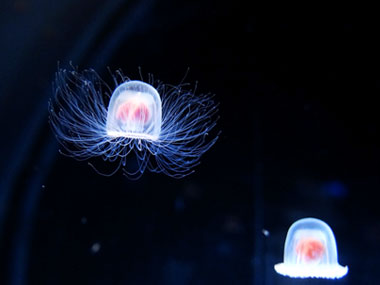vídeo 1/5
Potato perspective
Why do we think of the future as being in front?
“Where is the future? The tendency in our culture – and most, but not all, others – is to compare the body’s movement through space with its passage through time: ahead are the things we are on our way to encounter. We intuit that the past is linked to the space behind and the future to that in front. But research in the Journal of Experimental Psychology: General has found that some Western people buck this tendency: those born blind. (…)
Intriguingly, the use or not of a forward-backward spatial metaphor may have implications for the way that sighted and blind people experience time. For sighted people, past research has shown that events X months in the future feel subjectively closer than an event X months in the past – this makes sense in terms of a forward-backward spatial metaphor considering that the future is something that is always looming (visually) closer, while the past is always retreating. (…)
Blind people do show some time-space mappings: they, like sighted people, associate past events with the left-hand side of space rather than the right. This may reflect associations built up through reading, as both Western alphabetic text and braille share a left-to-right format. It seems that, whether sighted or blind, our minds use whatever reference points are available to make sense of the dimension that colours everything but can never quite be grasped – the experience by which, in the words of St Augustine, “what is present may proceed to become absent.”
Source: https://digest.bps.org.uk/2018/03/21/is-the-future-ahead-not-for-those-born-blind/
Serranías del Hornocal, Humahuaca, Argentina

Photo: Jörg Schwarz
Sociology and Film
- Filmography: A Short Guide to Sociology and Film
https://kenplummer.com/sociology/filmography-a-short-guide-to-sociology-and-film/
- Sociology Through Documentary Film
http://sociologythroughdocumentaryfilm.pbworks.com/w/page/17194965/FrontPage
- The Sociological Cinema
Abaporu (1928) – Tarsila do Amaral

Senselab + Inflections
“Based in Montreal, the SenseLab is an international network of artists and academics, writers and makers, from a wide diversity of fields, working together at the crossroads of philosophy, art, and activism.
Participants are held together by affinity rather than by any structure of membership or institutional hierarchy. The SenseLab’s event-based projects are collectively self-organizing. Their aim is to experiment with creative techniques for thought in the act. The SenseLab’s product is its process, which is meant to disseminate. The measure of success is the creative momentum that spins off into individual and group practices elsewhere, to seed new processes asserting their own autonomy. The SenseLab makes no claim to ownership, operating as much as possible on the principle of a gift economy.
Erin Manning founded the SenseLab in 2004 out of a desire to build a supportive environment conducive to new modes of encounter and expression. Her premise was that concepts are never pre-programmed. Rather, they are experimental effects of an on-going process which emerge in the doing, and merge with making. The concepts and techniques collectively arrived at over the first ten years of SenseLab actvities are explored in “Propositions for Thought in the Act” (in Erin Manning and Brian Massumi, Thought in the Act: Passages in the Ecology of Experience, University of Minnesota Press, 2014).”
~~~~~~~ http://senselab.ca/wp2/about/
Inflexion:
a tendency that precedes
not the obscure not the unformed
but that which is apprehended only as it is transformed
a creative in-between** After Bernard Cache (after Deleuze/Guattari, after Leibniz)
Inflexions:
an in-between journal of transformative tendency at the creative crossroads
of philosophy, art, and
technology.
“Inflexions is an open-access journal for research-creation sponsored by the Sense Lab. It publishes articles, short texts of various genres including poetry and ficto-theory, images, sound, and other multimedia content. We invite writing and/or other forms of expression actively exploring such issues as: (inter/trans/non) disciplinarity; the emergence of new modes of collaboration; micropolitics and the life and death of institutions; creativity, subjectivity and collectivity in cultural production; the ethics of aesthetics; the aesthetic as ethics. The goal is to promote experimental practices combining research and creation in such a way as to foster symbiotic links between philosophical inquiry, technological innovation, artistic production, and social and political engagement. Of continuing concern will be how these efforts may renew and recast relations between the concrete and the abstract, perception and conception, the body and technology. We hope the journal will become a tool for thinkers, builders, artists, informal groupings, and institutions to develop a mutually sustaining and enriching dialogue around these issues.”
~~~~~~~~~ http://www.inflexions.org/about.html
Bodys of
Artist unfortunately unknown.
Turritopsis dohrnii


This jellyfish has found a way to cheat death by actually reversing its aging process, according to National Geographic. If the jellyfish is injured or sick, it returns to its polyp stage over a three-day period, transforming its cells into a younger state that will eventually grow into adulthood all over again.
http://www.nytimes.com/2012/12/02/magazine/can-a-jellyfish-unlock-the-secret-of-immortality.html
https://immortal-jellyfish.com/
https://www.rd.com/culture/animals-that-live-forever/
O pensamento indígena amazônico – Indigenous amazonian thinking
Palestra do Prof. Eduardo Viveiros de Castro no Departamento de Antropologia (Museu Nacional) do Rio de Janeiro em 16/06/2009.
“Apresentação de algumas características marcantes do pensamento sócio cosmológico dos povos indígenas da Amazônia.
A primeira e principal delas é precisamente a concepção do cosmos como uma sociedade de sociedades, ou um coletivo de coletivos.
A segunda consiste na universalidade da condição humana enquanto substrato ontológico do cosmos.
A terceira diz respeito aos diferentes modos de interação possível entre os coletivos antropo-cosmológicos.”
